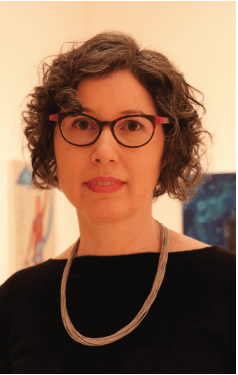Above: Detail from Archie Rand. 326: To Send the Impure from the Temple (Numbers 5:2), 2001-2006. From the series The 613. Acrylic on canvas. 20 x 16 in. Photo by Samantha Baskind
Scholars Insights on Art
What are the boundaries of Holocaust art? What has been the reception history of artworks that exceed those boundaries and defy normative conceptions of Jewishness? These questions are illuminated by little-known Caribbean artist Josef Nassy’s Tittmoning, which was created in a Nazi internment camp in 1944. In particular, Nassy’s oil painting suggests how, in our current decolonizing moment, we might rethink definitions of Holocaust and Jewish art to better reflect the porousness of histories and identities.

Josef Nassy. Tittmoning, 1944. Oil painting on wood. 14.21 x 12.48 in. United States Holocaust Memorial Museum Collection, Gift of the Severin Wunderman Family. Photo by Sarah Phillips Casteel
Born in Paramaribo, capital of the Dutch Caribbean colony of Suriname, in 1904, Nassy was descended from both enslaved Africans and Jewish settlers. His Sephardic surname and intricate genealogy typify the Eurafrican Jewish population that emerged in colonial Suriname as a result of Jewish plantation ownership, slaveholding, and intensifying contact between Jews and African-descended populations amid sharply unequal relations of power.i After spending his early years in Paramaribo, Nassy moved to New York City as a teenager and then settled in Belgium in the 1930s. In 1942, he was arrested as an enemy alien and imprisoned in civilian POW camps in Belgium and Germany for the duration of the war. During his internment, he created over two hundred drawings and paintings thanks to materials supplied by the International YMCA. In the 1980s, Nassy’s wartime corpus was acquired by a Belgian Jewish Holocaust survivor who subsequently donated the collection to the United States Holocaust Memorial Museum.ii
The men are likely African American jazz musicians Johnny Mitchell and Henry Crowder, both of whom Nassy sketched repeatedly but did not identify by name.
Tittmoning is a poignant double portrait of two Black prisoners interned in Ilag VII-Z in the village of Tittmoning, Bavaria. The men are likely African American jazz musicians Johnny Mitchell and Henry Crowder, both of whom Nassy sketched repeatedly but did not identify by name. Tittmoning thus attests not only to Nassy’s African diaspora presence in the camp but also to that of a number of other Black internees. Nassy presents Mitchell and Crowder in the austere, claustrophobic atmosphere of the medieval castle that served as their barracks. In contrast to the stiff, motionless posture characteristic of individual portraits, the men’s more casual poses convey their enforced intimacy and shared identity as prisoners. Mitchell is seated on the top bunk of a bed playing the guitar while Crowder lies on the bunk below reading, his head propped up in his left hand. Intent on their activities, the prisoners’ knitted brows and heavily shadowed faces convey psychological challenges of internment that are not captured by textual and photographic records of Ilag VII, including a wartime photograph of a smiling Mitchell in the USHMM collection.
As in another group portrait of Black internees that Nassy painted the previous year, in Tittmoning Mitchell’s guitar occupies the foreground of the image and is positioned slightly off-center. While Mitchell’s body and face turn away from the viewer, his guitar is seen head on. Its luminous orange tones draw the viewer’s eye while the bright white pages of Crowder’s book below provide a secondary focal point. The guitar and the book protrude out of the gloom that envelops Mitchell and Crowder, signaling the spiritual sustenance that music and reading offered in a context of profound uncertainty and disempowerment. Also similar to the earlier painting, an image is affixed to the wall behind the two prisoners. Possibly a pinup or artwork created by one of the prisoners, the image’s introduction into otherwise stark surroundings suggests how internees sought to reshape and thereby regain some control over their material environment.
The Nassy Collection depicts internees of various backgrounds, offering a valuable visual account of the daily lives of civilian POWs. To my knowledge, the collection is also the most extensive visual document of Black prisoners in the Nazi camp system—many of whom, paradoxically, had emigrated to Europe seeking greater freedom. Other depictions of Black internees in Ilag VII by white prisoner- artists adopted the visual language of cartoons and caricature. As a skilled painter of African and Jewish heritage, Nassy arguably was uniquely positioned to convey the Black internees’ complex psychologies and predicament. The postwar reception history of the Nassy Collection reveals, however, the difficulty of assimilating this vision to dominant institutional, scholarly, and memorial narratives. Nassy’s creolized Caribbean Jewishness, imprisonment in internment rather than concentration camps, and artistic focus on Black prisoners posed challenges for his works’ reception that have contributed to their invisibility. Yet his artworks are not simply passive objects awaiting analysis through existing interpretive frameworks. Rather, they are also countermemorial agents that actively call on us to reshape such frameworks and broaden our understanding of both Jewishness and wartime experience.

SARAH PHILLIPS CASTEEL is professor of English at Carleton University, where she is cross-appointed to the Institute of African Studies. She is the author most recently of Calypso Jews: Jewishness in the Caribbean Literary Imagination (Columbia University Press, 2016), which won a Canadian Jewish Literary Award, and co-editor of Caribbean-Jewish Crossings: Literary History and Creative Practice (University of Virginia Press, 2019).
iSee Aviva Ben-Ur, Jewish Autonomy in a Slave Society: Suriname in the Atlantic World, 1651–1825 (Philadelphia: University of Pennsylvania Press, 2020).
iiFor a fuller account of Nassy’s biography and artistic corpus, see Sarah Phillips Casteel, “Making History Visible: Dutch Caribbean Artist Josef Nassy’s Visual Diary of Nazi Internment,” Small Axe: A Caribbean Journal of Criticism 64 (March 2021): 28–46, and Casteel, “Outside the Frame: The Josef Nassy Collection and the Boundaries of Holocaust Art,” Jewish Social Studies (forthcoming). See also Monica Rothschild-Boros, In the Shadow of the Tower: The Works of Josef Nassy, 1942–1945 (Irvine, CA: Severin Wunderman Museum, 1989).